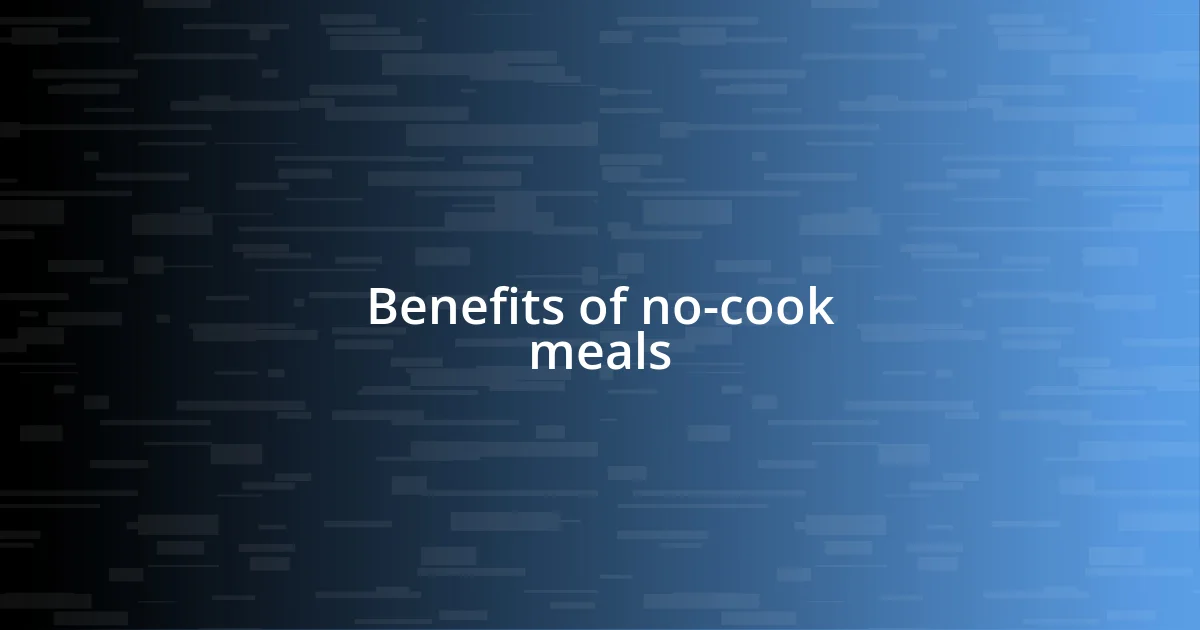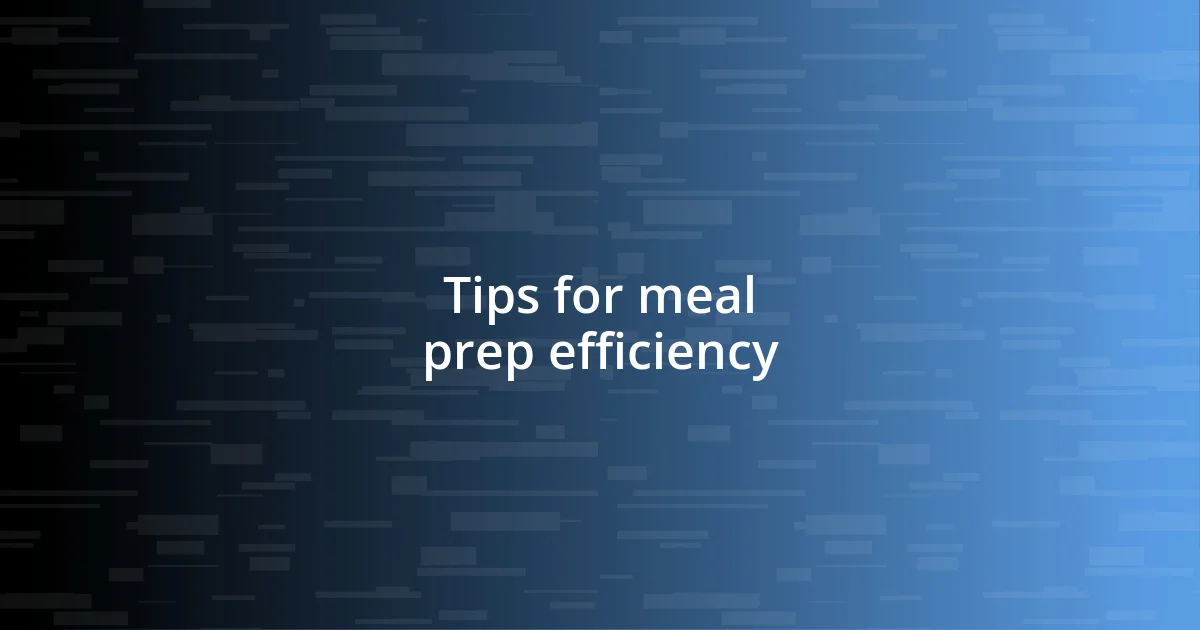Key takeaways:
- No-cook meals offer convenience, flexibility, and promote mindfulness, making them ideal for busy lifestyles.
- Essential ingredients for no-cook meals include fresh produce, high-quality cheeses, legumes, whole grains, and flavorful oils.
- Efficient meal prep techniques, such as weekly ingredient portioning and organizing pantry items, enhance the enjoyment and ease of preparing no-cook meals.

Understanding no-cook meals
No-cook meals can be a true lifesaver, especially on those busy days when the thought of turning on the stove feels overwhelming. I remember the first time I discovered this concept; it was during a hectic week filled with meetings and deadlines. I found myself reaching for ready-made meals out of convenience, but I craved something fresher and healthier. That’s when I turned to no-cook options, and it sparked a newfound creativity in my kitchen.
Understanding no-cook meals starts with recognizing that they can be as satisfying and flavorful as any dish that requires cooking. I often whip up vibrant salads with seasonal vegetables and a sprinkle of nuts or seeds for crunch. Have you ever experimented with a mix of fresh fruits, yogurt, and granola? It’s not just quick; it’s a delightful way to start or end the day, bringing a smile with every bite.
At their core, no-cook meals celebrate simplicity and freshness. They rely on high-quality ingredients that shine on their own. I still vividly recall a summer picnic where I prepared a platter of cheese, olives, and ripe tomatoes, feeling the warm sun on my face. It reminded me that sometimes, the best meals are the ones that need little preparation but deliver maximum enjoyment and flavor.

Benefits of no-cook meals
No-cook meals are incredibly convenient and a real game-changer for anyone with a busy lifestyle. I recall one particularly hectic summer when I had errands to run and a tight schedule. Instead of resorting to takeout, I tossed together a no-cook bowl with quinoa, canned chickpeas, diced cucumber, and a drizzle of olive oil. It was satisfying and nourishing, proving that you don’t need to spend hours in the kitchen to enjoy a healthy meal.
Another significant benefit of no-cook meals is the flexibility they offer. You can easily adapt ingredients based on your preferences or what’s available in your pantry. I often find myself experimenting with whatever fruits and veggies I have on hand. On one occasion, I grabbed some leftover rotisserie chicken, avocados, and a few fresh herbs, and created a delicious wrap that was ready in moments. This kind of spontaneity not only keeps meals exciting but allows for a diverse range of flavors.
A more emotional aspect of no-cook meals is their ability to foster mindfulness around eating. By spending less time cooking, I’ve found myself more engaged during meal times, appreciating the textures and flavors. I recently made a simple antipasti platter with my family, selecting each ingredient mindfully, sharing laughs, and enjoying the process rather than rushing. This turns a meal into an experience, one that nurtures both the body and the soul.
| Benefit | Description |
|---|---|
| Convenience | No-cook meals save time, allowing for quick preparation amidst busy schedules. |
| Flexibility | They enable the use of various ingredients based on personal preferences or pantry availability. |
| Mindfulness | No-cook meals encourage appreciation for food, turning meals into enjoyable experiences. |

Essential ingredients for no-cook meals
When I think about the essential ingredients for no-cook meals, certain items immediately come to mind. These staples can truly elevate your meals and make the process seamless. For instance, I always keep a selection of fresh produce on hand, like ripe avocados and colorful bell peppers, as they add a burst of flavor and nutrients. I remember a fantastic summer evening when I simply sliced some juicy tomatoes, topped them with fresh mozzarella and basil, and drizzled olive oil over the top. That refreshing caprese salad became a go-to for the warm months!
To streamline your no-cook meal prep, consider stocking the following essentials:
- Fresh fruits (berries, cherries, or apples)
- Leafy greens (spinach, arugula, or kale)
- High-quality cheeses (feta, goat cheese, or cheddar)
- Canned legumes (chickpeas, black beans, or lentils)
- Whole grains (quinoa, couscous, or rice)
- Nuts and seeds (almonds, walnuts, or pumpkin seeds)
- Flavorful oils (extra virgin olive oil or sesame oil)
- Fresh herbs (parsley, cilantro, or basil)
Having these items ready allows you to mix and match effortlessly. They each bring something unique to the table. One evening, I threw together a quick grain bowl using leftover quinoa, some cucumbers, and a handful of walnuts. I drizzled it with olive oil and a squeeze of lemon; it felt like a gourmet dish without any fuss! That simplicity doesn’t just fill your stomach; it nourishes your creativity in the kitchen.

Easy no-cook meal ideas
One of my favorite easy no-cook meals is a vibrant Mediterranean-style salad. Just the other day, I grabbed a can of artichoke hearts and mixed them with cucumber, cherry tomatoes, and feta cheese. As I drizzled a bit of balsamic glaze on top, I couldn’t help but think how colorful veggies can transform a simple meal into something truly delightful. Don’t you love when a dish looks as good as it tastes?
Another delightful idea is a sushi-style wrap using nori sheets. I remember making these when I had friends over for a casual lunch. I laid out avocados, shredded carrots, and sliced bell peppers, giving everyone the chance to create their own. It felt like a mini sushi party right in my kitchen! The best part? You can load them up with whatever you have, making it a versatile option for anyone.
Lastly, let’s not forget about snack boards. Recently, I put together a no-cook platter featuring different cheeses, cured meats, and seasonal fruits. It’s such a relaxed way to eat, and I found that it sparked great conversations. Have you ever noticed how sharing food can bring people closer together? Just serve it all on a beautiful board, and suddenly you have a stunning centerpiece that invites everyone to dig in!

Tips for meal prep efficiency
When it comes to meal prep efficiency, I find that dedicating just a little time each week can pay off immensely. For instance, setting aside an hour on Sundays to wash, chop, and portion fresh produce can make a world of difference during busy weekdays. I still remember the sense of accomplishment I felt after prepping some colorful bell peppers and crunchy cucumbers—those made grab-and-go lunches a breeze!
Another tip that has worked wonders for me is organizing my pantry and fridge in a way that highlights my go-to ingredients. I place the items I use most frequently within easy reach. One day, after a long, tiring workweek, I was thankful that I could effortlessly grab a container of prepped chickpeas and a jar of homemade dressing. It allowed me to whip up a nutritious salad in no time, and I found joy in how quickly I could create something delicious without any fuss.
Lastly, I recommend embracing versatility in your meal prep. Think about ingredients that can serve multiple purposes, like grilled chicken or roasted veggies. I once roasted a big batch of sweet potatoes, planning to use them for dinner. Unexpectedly, they turned into my go-to topping for breakfast bowls and lunchtime salads throughout the week. Isn’t it liberating to have a few key ingredients that can star in different roles? Simplifying meals while keeping them exciting is truly the best of both worlds!














